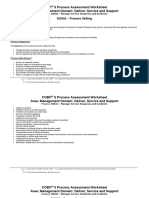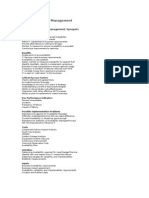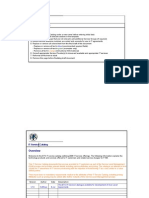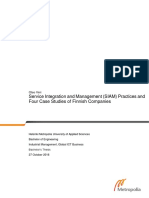Iso20000 2
Iso20000 2
Uploaded by
Karloz PsyCopyright:
Available Formats
Iso20000 2
Iso20000 2
Uploaded by
Karloz PsyOriginal Title
Copyright
Available Formats
Share this document
Did you find this document useful?
Is this content inappropriate?
Copyright:
Available Formats
Iso20000 2
Iso20000 2
Uploaded by
Karloz PsyCopyright:
Available Formats
Hong Kong Computer Society
LG1, No. 78 Tat Chee Avenue Kowloon Tong, Hong Kong Tel: (852) 2834 2228 URL: http://www.hkcs.org.hk Fax: (852) 2834 3003 Email: hkcs@hkcs.org.hk
Introduction to ISO 20000-1
K H Li HKSPIN ISO/IEC 20000 is the first formal international standard for IT Service Management (ITSM). This brief note provides an overview of this standard. ISO/IEC 20000 consists of two parts. Part 1 defines the specification in 10 clauses for achieving certification (the shall do things), while Part 2 provides the best practices for achieving the requirements stipulated in Part 1 (the should do things). The ISO/IEC 2000 series enables the service provider to understand how to enhance the quality of service delivered. Part 1 defines the requirements for delivering IT services by an integrated process approach. Processes are to be established with supporting resources from management, documentation, and competence, awareness and training. The Plan-Do-Check-Act (PDCA) methodology is recommended to apply to all processes. Brief description will be given in the following sections. Part 2 represents an industry consensus on quality standards for IT service management processes. As a code of practice, it serves as guidance and recommendations and is to be read in conjunction with part 1.
Scope, Terms and Definitions (clauses 1 & 2) Requirements for a management system (clause 3) Planning and implementing service management (clause 4)
Planning and implementing new or changed services (clause 5)
Service Delivery Processes (clause 6)
Capacity Management Service Continuity and Availability Management Service Level Management Service Reporting Information Security Management Budget and Accounting for IT Services
Control Processes (clause 9) Release Process (clause 10)
Release Management Configuration Management Problem Management
Relationship Processes Processes (clause 7)
Business Relationship Management Supplier Management
Resolution Processes (clause 8)
Incident Management Problem Management
Figure 1. ISO/IEC 20000 Structure
ISO/IEC 20000 promotes effective and efficient implementation of an integrated service management program. There are specific requirements with the establishment of service objectives and controls. ISO/IEC 20000 serves as a benchmark against which an organization can measure its service management execution and continual improvement. It identifies requirements for:Service management system, Service management lifecycle, and Service management processes.
The service management system defines management responsibilities, documentation requirements, and the rollout of the service management processes. IT governing policies, plans, processes and procedures shall be established. The service management lifecycle adopts iteratively the Plan-Do-Check-Act cycle, a four-stage process management cycle attributed to Edward Deming. As defined in ITIL Service Management Practices, the four stages within the context of IT services can be interpreted as:
Plan Do Check Act Design or revise Processes that support the IT Services Implement the Plan and manage the Processes Measure the Processes and IT Services, compare with Objectives and produce reports Plan and implement Changes to improve the Processes
The Service Management Processes include 13 processes in 5 process categories Service Delivery, Relationship, Resolution, Control, and Release. The tables below give a brief elaboration on the Service Management System and the Service Management Processes for an organization in the context of the PDCA lifecycle model. Table 1 PDCA in Service Management System (Institutionalization)
Plan
Requirements for Management System Ability to establish policies and framework for IT services Planning and Implementing Service Management Planning and Implementing New or Changed Services Ability to define management direction and responsibilities Ability to plan and approve new or changed services
Do
Allows it to provide documents and records for planning and operation and then Allows it to implement service management plan and process specific plans and than Allows it to provide adequate funding and resources and then
Check
Provide documents and records for operation and control, enabling it to Perform reviews, assessments, and audits, enabling it to
Act
Review and manage competencies and training needs for improved capabilities and maturity in establishing requirements for Management System which increase its ... Identify, measure, report, and manage the activities for improved capabilities and maturity in Planning and Implementing Service Management which increase its
Report outcomes achieved by the new or changed services, enabling it to
Perform post implementation reviews for improved capabilities and maturity in Planning and Implementing New or Changed Services which increase its ...
Table 2 PDCA in Service Delivery Processes
Plan
Service Level Management Process Service Reporting Process Ability to state services and service targets in SLA ... Ability to identify service reports
Do
Allows it to monitor and report its service level and then ... Allows it to produce reports and then
Check
Analyze for improvement actions, enabling it to ... Make informed decisions, enabling it to
Act
Improve its capabilities and maturity in Service Level Management Process which increase its ...
Communicate actions for improved capabilities and maturity in Service Reporting Process which increase its ...
Service Continuity and Availability Management Process Budgeting and Accounting for IT Services Process
Ability to develop the availability and service continuity plans Ability to budget for IT Services cost ...
Allows it to report the availability and then
Investigate the non-availability and failure of continuity test, enabling it to
Formulate action plans for improved capabilities and maturity in Service Continuity and Availability Management Process which increase its Justify the costs for the changes for improved capability and maturity in Budgeting and Accounting for IT Services Process which increase its ...
Allows it to monitor and report the costs and then
Check and controlled the costs, enabling it to
Capacity Management Process
Ability to produce capacity plans to address the business needs
Allows it to identify methods, procedures, and techniques then and
Evaluate the projected capacity and performance requirements, enabling it to
Maintain the capacity plans for service upgrades, change requests, new technologies, etc for improved capability and maturity in Information Security Management Process which increase its
Information Security Management Process
Ability to develop and communicate the information security policy
Allows it to perform security controls and monitor security incidents and then
Report and investigate security incidents, enabling it to
Plan for management actions and improvement measures for improved capabilities and maturity in Information Security Management Process which increase its
Table 3 PDCA in Relationship Processes
Plan
Business Relationship Management Process Supplier Management Process Ability to document supplier management process, assign contract manager and prepared SLA Ability to schedule regularly service reviews and interim meetings
Do
Allows it to establish complaints with escalation channels to customer and then Allows it to monitor service levels and manage suppliers and sub-contractors and then
Check
Assign individuals for whole business relationship process, enabling it to Review contracts regularly to keep meeting needs and obligations, enabling it to
Act
Derive improvement plans for improved capability and maturity in Business Relationship Management Process which increase its .. Plan and record actions for improved capability and maturity in Supplier Management Process which increase its
Table 4 PDCA in Resolution Processes
Plan
Incident Management Process Ability to define procedures for incidents management Problem Management Process Ability to identify and analyze proactively the cause of incidents Allows it to monitor and report problem resolutions and then Review the effectiveness of the problems resolutions, enabling it to
Do
Allows it to classify and manage major incidents and then
Check
Communicate with customers the progress, enabling it to
Act
Restore the agreed services and response to requests as soon as possible for improved capability and maturity in Incident Management Process which increase its Take preventive actions and plan improvement actions for improved capabilities and maturity in Problem Management Process which increase its
Table 5 PDCA in Control Processes
Plan
Configuration Management Process Ability to define policy for CIs, provide impact information for changes, and identify CIs Change Management Process Ability to put in place policies and procedures to control the authorization and implementation
Do
Allows it to record and control components of services and their configuration and then Allows it to assess, approve, and implement changes and reviews and then
Check
Perform, report, and review configuration audit, enabling it to
Act
Plan and document corrective actions for improved capabilities and maturity in Configuration Management Process which increase its
Analyze the change records for frequent recurrences, emerging trends, etc regularly, enabling it to
Plan and document change analysis and actions for improved capabilities and maturity in Change Management Process which increase its
Table 6 PDCA in Release Process
Plan
Release Management Process Ability to setup a release policy stating the frequency and type of releases
Do
Allows it to establish controlled acceptance test environments and then
Check
Analyze success and failure of releases with respect to business impact, IT operations, and support resources, enabling it to
Act
Plan and document actions for improved capabilities and maturity in Release Management Process which increase its ...
You might also like
- ITSM Knowledge Management Implementation Workshop - New YorkDocument124 pagesITSM Knowledge Management Implementation Workshop - New YorkvenvenchanNo ratings yet
- Batch PlantDocument35 pagesBatch PlantYogesh Badhe100% (6)
- IT Service Management: OwnershipDocument22 pagesIT Service Management: OwnershipchandrukanthNo ratings yet
- Service Level Management Leveraging Your Network InvestmentsDocument16 pagesService Level Management Leveraging Your Network InvestmentsΟλυμπίδης ΙωάννηςNo ratings yet
- 3-ITIL V3 OverviewDocument52 pages3-ITIL V3 OverviewRatheesh Kumar100% (1)
- WI WP ITSM ImplemetationWhite PaperDocument9 pagesWI WP ITSM ImplemetationWhite PaperalexandruNo ratings yet
- ITIL ConceptDocument57 pagesITIL Conceptsumanpk133100% (1)
- Oracle SR Escalation Process Quick Reference GuideDocument1 pageOracle SR Escalation Process Quick Reference GuideNitin SharmaNo ratings yet
- Knowledge Management System1Document9 pagesKnowledge Management System1sourav senNo ratings yet
- PinkSCAN Change MGMTDocument8 pagesPinkSCAN Change MGMTMartin LeckNo ratings yet
- Capacity Management: Jose Mathew Monica Jain MohanarajDocument12 pagesCapacity Management: Jose Mathew Monica Jain MohanarajecadreNo ratings yet
- DSS02 Manage Service Requests and IncidentsDocument14 pagesDSS02 Manage Service Requests and Incidentsnyamsuren.mncertNo ratings yet
- ITIL - A Guide To Access Management PDFDocument3 pagesITIL - A Guide To Access Management PDFBabul BhattNo ratings yet
- BMC - Maturity Models For ITIL Processes and FunctionsDocument4 pagesBMC - Maturity Models For ITIL Processes and FunctionsRoy YangNo ratings yet
- ITIL - An Example Schedule of Change PDFDocument1 pageITIL - An Example Schedule of Change PDFlemo100% (1)
- Iso 20000 Implementation Guide MyDocument8 pagesIso 20000 Implementation Guide MyvchristieNo ratings yet
- Capacity ManagementDocument3 pagesCapacity ManagementAbhimanyu KotwalNo ratings yet
- Capacity ManagementDocument21 pagesCapacity ManagementHuten VasellNo ratings yet
- Iso Iec 20000Document16 pagesIso Iec 20000Aswini Srinath100% (1)
- Ffiec Itbooklet Operations PDFDocument80 pagesFfiec Itbooklet Operations PDFAlex MelmanNo ratings yet
- CHG Mindmap v4Document1 pageCHG Mindmap v4Paul James BirchallNo ratings yet
- AvailabilityDocument9 pagesAvailabilityJyothi_B_PillaiNo ratings yet
- Requirements Itil v3 Managers BridgeDocument13 pagesRequirements Itil v3 Managers BridgeOmar MussiNo ratings yet
- ITIL Continual Service Improvement Sample MetricsDocument1 pageITIL Continual Service Improvement Sample MetricsAlejandro Cordero OrdoñezNo ratings yet
- TR143 Building Bridges ITIL and ETOM v1-0Document77 pagesTR143 Building Bridges ITIL and ETOM v1-0Puneet LuthraNo ratings yet
- ITSM Structure and RolesDocument12 pagesITSM Structure and RolesAno_NimskaNo ratings yet
- PROJECT ITSM - Shristi SharmaDocument19 pagesPROJECT ITSM - Shristi SharmaMaitri shahNo ratings yet
- Example Copy of ETS Service Catalog TemplateDocument13 pagesExample Copy of ETS Service Catalog TemplateSatish KumarNo ratings yet
- Continual Service Improvement (ITIL CSI) v3 - Process EvaluationDocument1 pageContinual Service Improvement (ITIL CSI) v3 - Process EvaluationAndrea GiulianiNo ratings yet
- Notes ITIL4 Session 4-ITIL PDocument7 pagesNotes ITIL4 Session 4-ITIL PSean HunterNo ratings yet
- The CMDB As The Brain of ITDocument4 pagesThe CMDB As The Brain of ITmojo_92No ratings yet
- Paris It Service Management 2-3-2021Document121 pagesParis It Service Management 2-3-2021sucharitha100% (1)
- Essentials: Powered by Alberto M. VasquezDocument30 pagesEssentials: Powered by Alberto M. VasquezAlberto M. VásquezNo ratings yet
- HL - ITSM Assessment v0.2Document23 pagesHL - ITSM Assessment v0.2Vamsi aravetiNo ratings yet
- C Gart63Document14 pagesC Gart63raj.raidurNo ratings yet
- A Practical Guide To ITSM and ITIL 3 - 3 - .Doc A Practical Guide To ITSM and ITIL 3 Part 1 Moments of TruthDocument26 pagesA Practical Guide To ITSM and ITIL 3 - 3 - .Doc A Practical Guide To ITSM and ITIL 3 Part 1 Moments of TruthGangi Reddy NallagonduNo ratings yet
- Process Narrative - SOX Project / IT Fixed Assets: PurposeDocument6 pagesProcess Narrative - SOX Project / IT Fixed Assets: PurposeZlatilNo ratings yet
- ISO 20k ChecklistDocument7 pagesISO 20k Checklistmaroli_yogeshNo ratings yet
- Process Improvement Calculations ToolsDocument65 pagesProcess Improvement Calculations ToolsNevets Nonnac100% (1)
- Problem Management Overview: HDI Capital Area Chapter September 16, 2009 Hugo Mendoza, Column TechnologiesDocument26 pagesProblem Management Overview: HDI Capital Area Chapter September 16, 2009 Hugo Mendoza, Column Technologies1buckeyeNo ratings yet
- Case Study 4 Defra UnITyDocument46 pagesCase Study 4 Defra UnITyRohitNo ratings yet
- 08 01 07 - Iso20000Document51 pages08 01 07 - Iso20000saieesha2012_8036449No ratings yet
- Availability ManagementDocument18 pagesAvailability Managementapi-3729551100% (1)
- Service Level Management Using IBM Tivoli Service Level Advisor and Tivoli Business Systems Manager Sg246464Document568 pagesService Level Management Using IBM Tivoli Service Level Advisor and Tivoli Business Systems Manager Sg246464bupbechanhNo ratings yet
- Communications Plan June 2017 Final 12oct17Document48 pagesCommunications Plan June 2017 Final 12oct17yashas sNo ratings yet
- ITIL Prep GuideDocument175 pagesITIL Prep GuideNitten HaajelaaNo ratings yet
- Introduction YaSM ISO 20000 Bridge PDFDocument15 pagesIntroduction YaSM ISO 20000 Bridge PDFAbdelfattahHabibNo ratings yet
- Help Desk PresentationDocument52 pagesHelp Desk PresentationEmente Emente100% (1)
- Rri - Service Integration and Management SIAM Practices and Four Case Studies of Finnish Companies PDFDocument88 pagesRri - Service Integration and Management SIAM Practices and Four Case Studies of Finnish Companies PDFOmkar YadavNo ratings yet
- Mary KayDocument15 pagesMary Kayapi-338273568100% (1)
- Itam PPT 1Document35 pagesItam PPT 1Karunesh MathurNo ratings yet
- BMC® Best Practice Process Flows For ITIL Asset Management PDFDocument50 pagesBMC® Best Practice Process Flows For ITIL Asset Management PDFlouie mabiniNo ratings yet
- Shift Left (Left) and KCS: Working Towards Better ServicesDocument3 pagesShift Left (Left) and KCS: Working Towards Better ServicesTOPdeskNo ratings yet
- Capacity MGMTDocument22 pagesCapacity MGMTArindam ChakravartyNo ratings yet
- SR Manager IT - Ops & SecurityDocument4 pagesSR Manager IT - Ops & Securitysaba siddiquiNo ratings yet
- Iso - Iec 20000Document22 pagesIso - Iec 20000Vincenzo OstoniNo ratings yet
- ITIL® 4 vs. ISO/IEC 20000-1:2018: Similarities and Differences & Process MappingDocument11 pagesITIL® 4 vs. ISO/IEC 20000-1:2018: Similarities and Differences & Process Mappingelisa navesNo ratings yet
- Computer security incident management Standard RequirementsFrom EverandComputer security incident management Standard RequirementsNo ratings yet
- Questionnaire For DistributorDocument5 pagesQuestionnaire For DistributorhemantdongreNo ratings yet
- Phy12 Exit Exam ReviewDocument9 pagesPhy12 Exit Exam ReviewAngelo Joshua De LeonNo ratings yet
- Roy HunterDocument26 pagesRoy HunterefcarrionNo ratings yet
- Rekapitulasi Man Power Per Area Maret 2017Document1 pageRekapitulasi Man Power Per Area Maret 2017Alfien PutraNo ratings yet
- FsfinaaalDocument28 pagesFsfinaaalJohn Paul EbuenNo ratings yet
- Food LubeDocument28 pagesFood LubeWaqasNo ratings yet
- Networking Interview Questions and AnswersDocument12 pagesNetworking Interview Questions and Answersashugolu02100% (1)
- Falco UAV Low Reynolds Airfoil DesignDocument25 pagesFalco UAV Low Reynolds Airfoil DesignredxusNo ratings yet
- Government Polytechnic Pen: Department of Mechanical EngineeringDocument11 pagesGovernment Polytechnic Pen: Department of Mechanical EngineeringRutujaNo ratings yet
- Design For Communities: F 4.4 Alternative Grid LayoutDocument4 pagesDesign For Communities: F 4.4 Alternative Grid LayoutaditNo ratings yet
- Mbeya University of Science and Technology: List of Selected Bachelor Students For The Academic Year 2020/2021 (ROUND 1)Document114 pagesMbeya University of Science and Technology: List of Selected Bachelor Students For The Academic Year 2020/2021 (ROUND 1)Franck LucaNo ratings yet
- Pre Installationfor Opgw 48 FDocument5 pagesPre Installationfor Opgw 48 FMayank PorwalNo ratings yet
- Newscoop 3 Cookbook 3.5.2 A4 DownloadDocument232 pagesNewscoop 3 Cookbook 3.5.2 A4 Downloadjac04No ratings yet
- Sicam Toolbox II en v2Document39 pagesSicam Toolbox II en v2hijas100% (1)
- Calculating Ground ResistanceDocument5 pagesCalculating Ground Resistancebouncerhawk67% (3)
- 4th B 9 Career Technology Mock QuestionsDocument7 pages4th B 9 Career Technology Mock Questionskurlsjordan100% (2)
- Customer - GID - 208-CI-EAU-BS-54165 REV-2 - CSU Control PhilosophyDocument7 pagesCustomer - GID - 208-CI-EAU-BS-54165 REV-2 - CSU Control Philosophysivasakti chp2No ratings yet
- Add32plus Acdcpwrcnvtr PDFDocument466 pagesAdd32plus Acdcpwrcnvtr PDFAtul SiddharthaNo ratings yet
- CCNA Routing and Switching Network Basics and Introduction To Networks Chapter 6 Skills Assessment - Packet TracerDocument5 pagesCCNA Routing and Switching Network Basics and Introduction To Networks Chapter 6 Skills Assessment - Packet Tracerel bartoNo ratings yet
- FL-001 DatasheetDocument4 pagesFL-001 DatasheetTrần PhongNo ratings yet
- Specific Heat CapacityDocument9 pagesSpecific Heat CapacityR Mathew0% (1)
- Repair and Rehabilitation of RCC Structures 2Document7 pagesRepair and Rehabilitation of RCC Structures 2RESHMA DHRUWNo ratings yet
- BRV Maintenance SheetDocument1 pageBRV Maintenance SheetdharhennaNo ratings yet
- 11 Chemistry CBSE Basic Concepts of ChemistryDocument3 pages11 Chemistry CBSE Basic Concepts of ChemistryNitesh GuptaNo ratings yet
- Vp-15-109-001-A01-P-237-004abc-D-006 Data Sheet For Steam TurbineDocument4 pagesVp-15-109-001-A01-P-237-004abc-D-006 Data Sheet For Steam TurbineRicardo NapitupuluNo ratings yet
- 1.relation Between Torsion Moment, Torsion Angle and Span LengthDocument15 pages1.relation Between Torsion Moment, Torsion Angle and Span LengthMoiz Amir100% (1)
- 02 - Upa 150S-34Document2 pages02 - Upa 150S-34Rojo ArrebolNo ratings yet
- CMGL Sofware On WindowsDocument27 pagesCMGL Sofware On WindowsLapoNo ratings yet
- Poster Format For Go Green - AwardsDocument1 pagePoster Format For Go Green - AwardsKamlakar WaghNo ratings yet

























































































